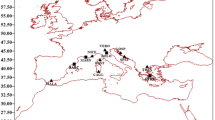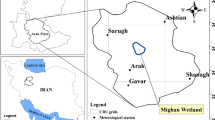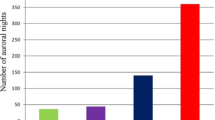Abstract
Solar activity, such as sunspots and flares, has a great impact on humans, living beings, and technologies in the whole world. Changes in sunspots will influence high-frequency and space-navigation radio communications. Based on the full-disk, southern and northern hemispheres sunspot areas (SAs) data in 1874–2023 from the Royal Observatory, Greenwich (RGO) USAF/NOAA, extreme value theory (EVT) is applied to predict the trend of the 25th and 26th solar cycles (SCs) in this work. Two methods with EVT, the block maxima (BM) approach and the peaks-over-threshold (POT) approach, are employed to research solar extreme events. The former method focuses on each block’s maximum sunspot areas value and is applied for the generalized extreme value (GEV) distribution. The latter method aims to select the extreme values exceeding a threshold value and is used to obtain the generalized Pareto (GP) distribution. It is the first time that the EVT is applied on the sunspot areas data from the Royal Observatory, Greenwich (RGO) USAF/NOAA. The analysis indicates that the estimated 8-year return levels for sunspot areas are 5701 and 6258 using the two methods, while the estimated 19-year return levels are all 7165. This suggests that the trends of the 25th and 26th solar cycles will be stronger than that of the 24th solar cycle.









Similar content being viewed by others
References
Acero F. J., Carrasco V. M. S., Gallego M. C., García J. A., Vaquero J. M. 2017, Astrophys. J., 839, 98
Acero F. J., Gallego M. C., García J. A., Usoskin I. G., Vaquero J. M. 2018a, The Astrophysics Journal, 853, 80
Acero F. J., García J. A., Gallego M. C. 2011, J. Clim., 24, 1089
Acero F. J., García J. A., Gallego M. C., Parey S., Dacunha-Castelle D. 2014, J. Geophys. Res. (Atmos.), 119, 39
Acero F. J., Vaquero J. M., Gallego M. C., García J. A. 2018b, Geophys. Res. Lett., 45, 9435
Asensio Ramos A. 2007, Astron. Astrophys., 472, 293
Attia A.-F., Ismail H. A., Basurah H. M. 2013, Astrophys. Space Sci., 344, 5
Babcock H. W. 1961, Astrophys. J., 133, 572
Bernstein J. P., Bhavsar S. P. 2001, Mon. Not. R. Astron. Soc., 322, 625
Bhavsar S. P., Barrow J. D. 1985, Mon. Not. R. Astron. Soc., 213, 857
Bhowmik P., Jiang J., Upton L., Lemerle A., Nandy D. 2023, Space Sci. Rev., 219, 40
Bhowmik P., Nandy D. 2018, Natu. Commun. 9, 5209
Cameron R., Schüssler M. 2008, Astrophys. J., 685, 1291
Castillo E., Hadi A. S., Balakrishnan N., Sarabia J. M. 2004, Wiley
Chen Y.-Q., Zheng S., Xiao Y.-S. et al. 2021, Atmosphere, 12, 1176
Choudhuri A. R., Chatterjee P., Jiang J. 2007, Phys. Rev. Lett., 98, 131103
Chowdhury P., Jain R., Ray P. C., Burud D., Chakrabarti A. 2021, Sol. Phys., 296, 1
Coelho C. A. S., Ferro C. A. T., Stephenson D. B., Steinskog D. J. 2008, J. Clim., 21, 2072
Coles S. G. 2001, An Introduction to Statistical Modeling of Extreme Values (Berlin: Springer)
Deng L. H., Li B., Xiang Y. Y., Dun G. T. 2016, Astron. J., 151, 2
Deng L. H., Zhang X. J., Deng H., Mei Y., Wang F. 2020, Mon. Not. R. Astron. Soc., 491, 848
Dikpati M., de Toma G., Gilman P. A. 2006, Geophys. Res. Lett., 33, L05102
Elvidge S., Angling M. J. 2018, Space Weather Int. J. Res. Appl.
Ferreira A., de Haan L. 2013, arXiv e-prints, arXiv:1310.3222
Gilli M., Keellezi E. 2006, Comput. Econ., 27, 207
Gopalswamy N., Makela P., Akiyama S., Yashiro S., Thakur N. 2018, J. Atmos. Sol. Terr. Phys., 179, 225
Hathaway D. H. 2015, Living Rev. Sol. Phys., 12, 4
Heristchi D., Mouradian Z. 2009, Astron. Astrophys., 497, 835
Javaraiah J. 2015, New Astron., 34, 54
Jiang J., Cao J. 2018, J. Atmos. Sol. Terr. Phys., 176, 34
Karak B. B. 2023, Living Rev. Sol. Phys., 20, 3
Karak B. B., Choudhuri A. R. 2011, Mon. Not. R. Astron. Soc., 410, 1503
Karak B. B., Mandal S., Banerjee D. 2018, Astrophys. J., 866, 17
Kitiashvili I. N. 2021, Mon. Not. R. Astron. Soc., 505, 6085
Kumar P., Biswas A., Karak B. B. 2022, Mon. Not. R. Astron. Soc., 513, L112
Love J. J. 2020, Space Weather, 18, e02255
Mandal S., Krivova N. A., Solanki S. K., Sinha N., Banerjee D. 2020, Astron. Astrophys., 640, A78
Nandy D. 2021, Sol. Phys., 296, 54
Noble P. L., Wheatland M. S. 2012, Sol. Phys., 276, 363
Nogaj M., Yiou P., Parey S., Malek F., Naveau P. 2006, Geophys. Res. Lett., 33, L10801
Pala Z., Atici R. 2019, Sol. Phys., 294, 50
Petrovay K. 2020, Living Rev. Sol. Phys., 17, 2
Prasad A., Roy S., Sarkar A., Chandra Panja S., Narayan Patra S. 2022, Adv. Space Res., 69, 798
Rigozo N. R., Souza Echer M. P., Evangelista H., Nordemann D. J. R., Echer E. 2011, J. Atmos. Sol. Terr. Phys., 73, 1294
Sarp V., Kilcik A., Yurchyshyn V., Rozelot J. P., Ozguc A. 2018a, Mon. Not. R. Astron. Soc., 481, 2981
Sarp V., Kilcik A., Yurchyshyn V., Rozelot J. P., Ozguc A. 2018b, Mon. Not. R. Astron. Soc., 481, 2981
Schatten K. H., Scherrer P. H., Svalgaard L., Wilcox J. M. 1978, GRL, 5, 411
Tsiftsi T., De la Luz V. 2018, Space Weather, 16, 1984
Willis D. M., Tulunay Y. K. 1979, Sol. Phys., 64, 237
Acknowledgements
The authors thank the Royal Observatory, Greenwich (RGO) USAF/NOAA that provided the data. This research is supported by the National Natural Science Foundation of China under Grant Numbers U2031202, 12203029 and 11873089. The authors also thank the support of Yunnan Key Laboratory of Solar Physics and Space Science under the Number YNSPCC202208. This work is also supported by the Yunnan Fundamental Research Projects (grant no. 202301AV070007) and the ‘Yunnan Revitalization Talent Support Program’ Innovation Team Project (202405AS350012).
Author information
Authors and Affiliations
Corresponding author
Rights and permissions
Springer Nature or its licensor (e.g. a society or other partner) holds exclusive rights to this article under a publishing agreement with the author(s) or other rightsholder(s); author self-archiving of the accepted manuscript version of this article is solely governed by the terms of such publishing agreement and applicable law.
About this article
Cite this article
Zhang, R., Chen, YQ., Zeng, SG. et al. Extreme value theory applied to long-term sunspot areas. J Astrophys Astron 45, 14 (2024). https://doi.org/10.1007/s12036-024-09999-3
Received:
Accepted:
Published:
DOI: https://doi.org/10.1007/s12036-024-09999-3




